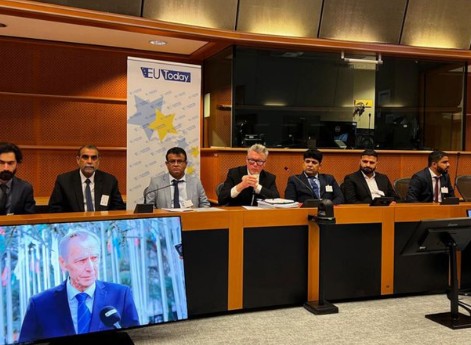
The revolving door of Pakistan’s health ministry is more than a political spectacle; it is a symptom of a governance system in chronic disarray. In recent years, the country has witnessed an alarming rate of ministerial turnover in its health sector, with leadership often changing hands every few months.
Each new appointment is accompanied by grand statements of reform, yet with each departure, those promises vanish into bureaucratic inertia.
The result is a healthcare system suspended in perpetual instability, unable to implement meaningful policy or deliver consistent services to a population that desperately needs both.
Pakistan’s healthcare crisis is often blamed on resource shortages, a lack of medical expertise, or population pressures.
In reality, the problem lies less in the availability of talent than in the absence of administrative continuity. The country boasts a considerable pool of skilled doctors, nurses, and allied health professionals.
Yet their ability to deliver quality care is continuously undermined by an ever-shifting governance framework.
Hospitals are overburdened, rural clinics remain chronically under-equipped, and public health initiatives falter before they can gain traction. These failures are not the result of incompetence at the individual level but of structural dysfunction at the top.
The cost of constant change
When ministerial leadership changes every few months, long-term strategy becomes impossible.
Policies requiring years to implement — whether strengthening primary care networks, expanding vaccination coverage, or upgrading hospital infrastructure — are abandoned midway or altered with each reshuffle.
Officials are forced to focus on immediate visibility rather than sustainable outcomes, creating a cycle where short-term initiatives are prioritised over systemic reform.
The very bureaucracy meant to implement these policies becomes paralysed, caught between directives that constantly shift in tone and priority.
Reports indicate that this pattern of instability is not a recent phenomenon. Over the past decade, Pakistan has witnessed a succession of health ministers, each with limited time to understand the system, let alone introduce structural reforms. Public health programmes suffer discontinuity, funding allocations are inconsistently applied, and regulatory oversight becomes erratic.
Hospitals wait for new directives; clinics struggle without updated guidelines; patients bear the brunt of the inefficiency.
The human cost is profound — preventable diseases flourish, maternal and child mortality rates remain stubbornly high, and the trust of the population in public healthcare erodes further.
The governance gap
The paradox of Pakistan’s healthcare predicament is stark.
The country does not face a shortage of medical knowledge but a lack of administrative cohesion. Doctors, nurses, and paramedics routinely demonstrate competence and dedication, yet their efforts are frequently neutralised by flawed management.
Hospitals are plagued by misaligned resource distribution, delayed procurement, and fragmented coordination between provincial and federal authorities.
Rural health centres, which serve the most vulnerable populations, often function without essential equipment, trained personnel, or basic medicines.
This administrative vacuum leaves public health dependent on ad hoc interventions rather than strategic planning.
A flood of directives from newly appointed ministers may promise upgrades, training, or technology procurement, but these initiatives rarely survive the departure of the official who championed them.
The system’s fragility is exposed not in times of routine service, but in moments of crisis. When disease outbreaks, natural disasters, or health emergencies strike, the lack of institutional memory and continuity amplifies their impact, turning manageable situations into large-scale tragedies.
Climate and compounding challenges
Adding urgency to this governance crisis are the new public health threats posed by climate change.
Pakistan faces an increasing frequency of heatwaves, floods, and shifting patterns of infectious disease.
Each of these developments places additional strain on hospitals and healthcare workers. Floods displace millions, creating conditions ripe for waterborne diseases. Heatwaves exacerbate chronic conditions like cardiovascular disease, while vector-borne illnesses expand into regions previously unaffected.
Addressing these emerging challenges requires coordinated, forward-looking policies — exactly what the constant ministerial reshuffling undermines.
Effective public health responses to climate-related crises require clear communication channels, consistent leadership, and pre-established emergency protocols.
In a system where ministers change every few months, such planning is impossible, leaving communities exposed and health workers scrambling to respond without strategic guidance.
The human toll
The consequences of this instability are both visible and invisible. Patients experience it in long queues, delays in treatment, and inconsistent quality of care.
Rural communities feel it in the absence of functional clinics and mobile health units. Nationwide, public confidence in government healthcare erodes with each headline announcing yet another ministerial appointment.
The persistent gap between medical expertise and patient outcomes is not an accident; it is the inevitable outcome of a system in which governance, rather than medicine, is the weakest link.
Children, pregnant women, and the chronically ill are disproportionately affected.
Immunisation campaigns falter when leadership changes disrupt planning and supply chains. Rural birthing centres remain understaffed or under-resourced, contributing to preventable maternal and infant deaths.
Health emergencies, whether outbreaks of dengue, measles, or polio, are exacerbated by fragmented leadership and inconsistent policy enforcement.
The tragedy is that these are not problems of knowledge but of organisation, planning, and oversight — all functions dependent on stable, accountable governance.
A system in stasis
Beyond immediate patient outcomes, the constant ministerial shuffle reflects a deeper malaise in Pakistan’s governance structure.
The healthcare system, instead of evolving as a resilient public service, remains trapped in a cycle of reaction and improvisation. Leadership is transient; programs begin with enthusiasm and end in neglect.
Bureaucracies, left to navigate the shifting priorities of successive ministers, lose coherence and capacity. Institutional knowledge dissipates as officials are forced to realign priorities with each reshuffle.
The irony is that Pakistan’s medical professionals are capable and dedicated. The country possesses the expertise necessary to deliver quality care and implement large-scale public health programmes.
What is missing is the continuity and foresight of governance — a framework within which medical talent can translate into measurable health outcomes.
Without this, hospitals continue to operate as reactive institutions, clinics function as stopgap solutions, and patients remain at the mercy of systemic unpredictability.
Governance over capacity
Ultimately, Pakistan’s healthcare crisis is not rooted in the inability of its medical personnel but in the instability of its governance.
Frequent ministerial changes have turned the health ministry into a revolving door, where policy, accountability, and institutional memory are casualties.
The public, particularly the most vulnerable, bears the brunt of this instability in daily encounters with overburdened hospitals and under-equipped clinics.
The challenges posed by climate change, rural health disparities, and chronic underfunding are exacerbated by the absence of consistent leadership.
Each reshuffle disrupts strategic initiatives, undermines long-term planning, and erodes public trust. The system is caught in a loop where reform is promised but never realised, and the promise of medical expertise remains unfulfilled in practice.
In Pakistan, the problem is not the absence of doctors, nurses, or technical skills. It is the absence of governance that can turn those skills into sustainable health outcomes.
Until leadership becomes stable and policy continuity is ensured, hospitals will remain overburdened, rural health centres under-equipped, and millions of patients denied the simple dignity of reliable care. The human cost of this instability is immediate, tangible, and unforgiving — and it grows with every ministerial shuffle.






